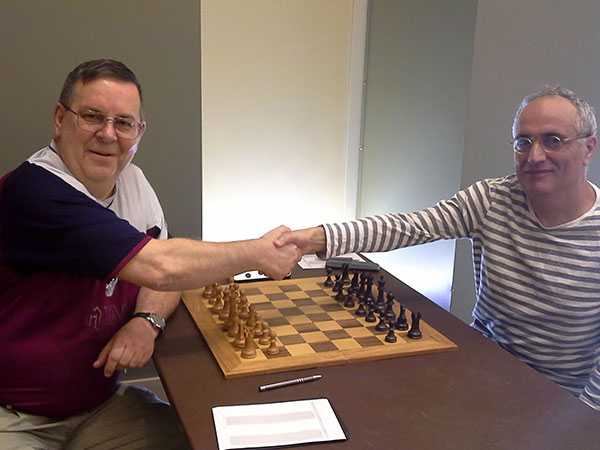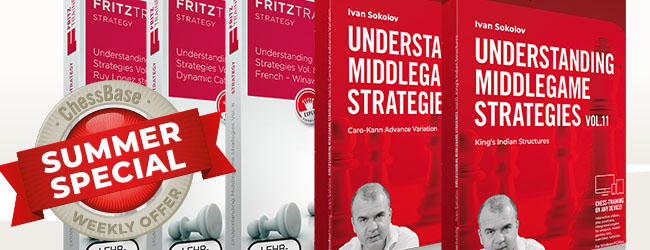I could have done it some time ago, since the age of 50 is eligible, but only this year I finally decided to act my age and participated in the U.S. Senior Open. A big part of that decision was the convenience. This year's venue was the St. Olaf College in historic Northfield, Minnesota.
Northfield earned its place in American history when the notorious gang led by famous bandit Jesse James met more than their match in ordinary citizens of a small town. A gunfight that ensued after a bank robbery claimed the lives of two of the bandits, while others were later hunted down by a Northfield posse. Only the James brothers, Jesse and Frank, were able to escape. A great example of an Average Joe's bravery and the reason why, to this day, we have very few bank robberies here in the Upper Midwest. It happened in 1876, but St. Olaf College was founded two years earlier.
Today St. Olaf is a four-year liberal arts school with a strong academic reputation. It is also the host of a yearly Ole Chess camp, run by NM Kevin Bachler and his team of merry men and women. Together with my wife, we have been fortunate to serve as instructors at Ole Chess for the past few years, and this year it was immediately followed by both the U.S. Senior and U.S. Junior opens. Seeing that I wouldn't even have to move out of my room I figured I'd give it a shot.
The Senior attracted only two Grandmasters, but the overall field of 95 players was an impressive turnout. After three days and six rounds of play this is how it stood.

The first thing you notice is your favorite author in clear first. That makes it two out of two this year so far — check out my report on the Larry Evans Memorial in Reno in April — but it was anything but easy.
Having surrendered a draw to the New York National Master Dexter Thompson, I found myself trailing GM Dmitry Gurevich by half a point with two rounds remaining. The stage was set for the following critical game in Round 5.

Two veteran grandmasters, veteran rivals, meet up to decide yet another event in their careers | Photo: Alex Yermolinsky
Alex Yermolinsky - Dmitry Gurevich
| Replay and check the LiveBook here |
Please, wait...
1.Nf3 d5 2.g3 Nf6 3.Bg2 e6 4.0-0 Be7 5.d3 c5 6.Nbd2 Nc6 7.e4 0-0 8.Re1 8.e5 Nd7 9.Re1 b5 10.Nf1 b4 11.h4 a5 12.Bf4 a4 13.a3! bxa3 14.bxa3 14...Na5? 14...Ba6 15.Ne3 Rb8 14...Re8 15.Ne3 Bb7 16.h5 Bf8 17.Rb1 Rb8 18.c4 dxc4 19.dxc4 Qc7 20.Qxa4 Nd4 15.Ne3 Ba6 16.Bh3 d4 17.Nf1 Nb6 18.Ng5! Nd5 19.Bd2 Bxg5 20.Bxg5 Qd7 21.Qh5 Rfc8 22.Nd2 Nc3 23.Bf6! Qe8 24.Ne4 g6 25.Qg5 Nxe4 26.Rxe4 c4 27.h5 cxd3 28.Rh4 Ra7 29.Bg2 dxc2 30.Qh6 Qf8 31.Qxh7+‼ 8...Qc7 9.e5 9.Qe2 Re8!? 10.e5 10.Nf1 d4 11.e5 Nd5 12.Ng5 h6 13.Bxd5 exd5 14.e6 hxg5 15.exf7+ Kxf7 16.Qh5+ Kf8 17.Qh8+ Kf7= 10...Nd7 11.Nf1 f6! 9...Ng4 10.Qe2 f6 11.exf6 Bxf6 12.c3 12.Nb3 b6 13.c4 Qf7 14.Bf4 Bb7 15.Qxe6 Qxe6 16.Rxe6 Nb4 12.h3 Nd4?! 12...Nge5 13.Nxe5 Bxe5 14.c3 Bd6 13.Nxd4 Bxd4 14.hxg4 Rxf2 15.Qxf2 Qxg3 16.Ne4 Bxf2+ 17.Nxf2 Bd7 18.Re3 Qc7 19.Bd2 12...Bd7 13.h3 Nge5 14.Nh2!? 14...Ne7?! 14...Rae8! 15.f4 Ng6 16.Ng4 Be7 17.Nf3 17.h4? Bxh4 18.gxh4 Nxf4 17...h5! 15.Ndf3! Nxf3+ 16.Bxf3 Ng6 17.Ng4 Be7 18.h4 Bd6!? 18...h6 19.h5 Nh8 20.Ne5± 19.h5 Ne5! 20.Nxe5 Bxe5 21.h6! 21.Bg4? Bxg3! 21...Bd6 21...g6 22.Bg2 22.Be3 b6 23.d4 Bd6 24.Bg4 Rae8 25.f4 cxd4 26.cxd4 26.Bxd4 e5! 27.Bxd7 Qxd7 28.Bxe5 Qh3 26...b5 27.Rac1 Qb6 28.Kg2 Rf7 22...Bd6 23.Bg5 Rae8 24.Qd2 22.hxg7 Rf6 22...Kxg7 23.Be3 Rf6 24.d4 Raf8 25.Bg2 23.Bg5! Rg6 24.Bh4 Rxg7 25.c4 Rf8?! 25...d4 26.Qe4 Rf8 27.Qxb7 Qxb7 28.Bxb7 Rb8 29.Be4 Rxb2 30.Kf1 Rf7 31.Re2 Rb6 32.Kg2 26.cxd5 exd5 27.Bxd5+ Kh8 28.Rac1 Bg4 29.Qe3 b6 30.Bg5! Rg6 31.Bh6 Rd8 32.Qe8+ Bf8 33.Bf4 33.Bd2!+- Bf3 34.Bc3+ Rg7 35.Qf7 33.Bxf8 Rxe8 34.Rxe8 Qd7 35.Rce1 Qxd5 36.Bd6+ Kg7 37.R1e7+ Kf6 37...Kh6 38.Bf4+ Rg5 39.Re5 38.Rf8+ Kg5 39.Bf4+ Kh5 40.Rxh7+ Rh6 41.Rxh6# 33...Rxe8 34.Bxc7 Rc8 35.Be5+ Bg7 36.Rc4 Bxe5 37.Rxe5± h5 38.d4 h4 39.dxc5 hxg3 40.fxg3? 40.f3! Bd7 41.Re7+- 40...Rxc5 41.Rxc5 bxc5 42.Kf2 42...Kg7 43.Be4 Rf6+ 44.Ke3 Be6 45.a3 45.Rxc5 Bxa2 46.Ra5 45...c4 46.Ra5 Rf7 47.Ra6 Re7 48.Kd4+- Rd7+ 49.Ke5 Bf7 50.g4 Re7+ 51.Kf4 Bg8 52.Rd6 Rc7 53.g5 Bf7 54.Rc6 Rd7 55.g6 55.a4 55...Bd5 56.Bxd5 Rxd5 57.Rxc4 a5 57...Kxg6 58.Rc6+ Kh5 59.b4 Rd7 60.Kf5 Rb7 61.Rc4+- 58.Ke4 Rb5 58...Rh5 59.Kd4 Kxg6 60.Rc5 Rh2 61.Kc3 a4 62.Rc4+- 59.b4 axb4 60.axb4 Kxg6 61.Kd4 Kf6 62.Rc6+ Ke7 63.Kc4 Rb8 64.b5 Kd7 65.Kc5 Rb7 65...Rc8 66.Rxc8 Kxc8 67.Kb6 66.Rh6 Kc8 67.Rh8+ Kc7 68.b6+ 1–0 - Start an analysis engine:
- Try maximizing the board:
- Use the four cursor keys to replay the game. Make moves to analyse yourself.
- Press Ctrl-B to rotate the board.
- Drag the split bars between window panes.
- Download&Clip PGN/GIF/FEN/QR Codes. Share the game.
- Games viewed here will automatically be stored in your cloud clipboard (if you are logged in). Use the cloud clipboard also in ChessBase.
- Create an account to access the games cloud.
| Yermolinsky,A | - | Gurevich,D | - | 1–0 | 2017 | C00 | US Senior Open | 5 |
Please, wait...
The King’s Indian Attack is a unique opening system in that it offers White a dynamic and interesting game but without the need to know reams of theory. In addition to being easy to learn it has an excellent pedigree, leading exponents including great players such as Bobby Fischer, Tigran Petrosian, David Bronstein, Viktor Korchnoi, Leonid Stein and Lev Psakhis. GM Nigel Davies presents a complete repertoire for White.
A satisfying result, but the work wasn't done yet. Before the last round I was tied for first with NM Mark Dejmek, with a large group of players following just a half-point behind. To make matters worse, I was served with my fourth Black in the tournament. See for yourself how tense a last-round battle can be in American Swiss events.
Mark Dejmek - Alex Yermolinsky
| Replay and check the LiveBook here |
Please, wait...
1.e4 c5 2.Nf3 d6 3.d4 cxd4 4.Nxd4 Nf6 5.Nc3 Nc6 6.Bc4 Qb6 7.Nxc6 7.Nb3 7.Ndb5 7.Nde2 7...bxc6 8.0-0 8...e6 8...g6 9.Qe1 9.e5 dxe5 10.Qe2 Qd4 11.Be3 Qd6 12.Rad1 Qc7 13.f4 Bg4 14.Qf2 e4 9...Qc7 9...Qc5 10.b3 Bg7 11.Bb2 0-0 12.Na4 Qh5 13.f3 10.f4 Bg7 11.e5! Nd5 12.Bxd5 cxd5 13.Be3 Bb7 14.exd6 Qxd6 15.Nb5 Qc6 16.Bd4 9.Bf4! 9.Qe2 Nd7 10.Qh5 10.Na4 Qa5 11.b3 Ne5 12.Bd2 Qc7 10...Qc5 11.Qxc5 Nxc5 12.b4 Ba6! 9...Qxb2 9...d5? 10.exd5 cxd5 11.Nb5 dxc4 12.Bc7 10.Qd3 10...e5 10...Qb4 11.Rab1 11.Rfd1 Nd7 11...e5 12.Bxe5 12.Rab1 Qc5 13.Bb3 Ne5 14.Bxe5 Qxe5 15.Ba4 Bd7 15...Qc5 16.e5 d5 17.Ne4 16.Rb7 11...Qc5 12.Rfd1 e5 13.Bg5 Be7 14.Bxf6 gxf6 15.Ne2 15.Nd5 Bd8 16.Ne3± 15...Be6? 16.Bxe6 fxe6 17.Rb7 11.Bg5 Qa3 11...Qb8 12.Rab1 Qc7 13.Bxf6 gxf6 14.Ba6 Be7 15.Bxc8 Qxc8 16.Nd1± 12.Rab1 12.Bxf6! gxf6 13.Rab1 Bg7 14.Rb3! Qc5 15.Nd5! 0-0 16.Nc7 12...Be7 13.Rb3 Qc5 14.Bxf6 Bxf6 15.Nd5! Bd8 16.Nb4! Bd7?! 16...Bb7 17.Bxf7+! Kxf7 18.Qf3+ Bf6 19.Nd3 16...0-0! 17.Nxc6 Bd7 18.Nxd8 Raxd8 19.Bd5 Rc8 20.c4 Bc6= 17.Na6 Qd4 18.Qe2 d5 19.exd5 0-0?! 19...cxd5 20.Bb5+- 19...Bg4 20.Qd3 Qxd3 21.cxd3 cxd5 22.Bxd5 Rc8 23.Rb7 0-0 24.Nb4 Rc7= 20.dxc6? 20.c3! Qf4 21.g3 Qh6 22.Nb8! Bh3 23.Rfb1± 20.Rd1? Bg4 21.Rxd4 Bxe2 22.Re4 Bxc4 23.Rxc4 cxd5 24.Rc5 Bb6 25.Rxd5 Rac8 20.Nb8! cxd5 20...Bg4 21.Qd3 21.Nxd7 dxc4 22.Rd1 Qxd1+ 23.Qxd1 cxb3 24.Nxf8 bxa2 25.Qa1 Kxf8 26.Qxa2 Bb6 20...Bxc6 21.Rd1 Qe4 22.Qxe4 Bxe4 23.Bd3 23.Bd5 Bxc2 23...Bxd3 24.Rdxd3 Rc8 25.c3 Bb6 26.Kf1 e4 27.Rd7 Rfd8 27...f5 28.Nb4 Rfd8 29.Rxd8+ Rxd8 30.Ke2 g6 31.c4 Rc8 32.Nd5 Rxc4 33.Nxb6 axb6 34.Rxb6 Rc2+ 35.Ke3 Rxa2 36.Rb7= 28.Rxd8+ Rxd8 29.Ke2? 29.c4 29...Rd5 30.Nb4! 30.c4 Ra5 31.Nb4 f5 32.a3 Bc5 33.Nc2 Ra4 30...Rf5 31.f3 exf3+ 32.gxf3 Rh5 33.Kd3 g6? 33...Rxh2 34.Nd5 Rh6! 35.c4 Rd6 34.c4 Rxh2 35.Nd5 Rxa2 36.Nxb6 axb6 37.Rxb6 37...Ra3+ 38.Kd4! Rxf3 39.Rb8+! 39.c5 Kf8 40.Rb7 Ke8 41.c6 Kd8 42.Kc5 Kc8 43.Kd6 39...Kg7 40.c5 Rf1 41.c6 Rc1 42.Kd5 Kf6 43.Kd6 Rd1+ 44.Kc7? 44.Kc5 Rc1+ 45.Kd6= 44...h5 45.Rd8 Rc1 46.Kd7? 46.Kd6 46...h4? 46...g5! 47.c7 g4 48.c8Q Rxc8 49.Rxc8 g3 50.Rg8 h4 51.Kd6 Kf5-+ 47.c7 g5 48.c8Q Rxc8 49.Rxc8 h3 50.Rc6+? 50.Rh8 g4 51.Kd6 Kf5 51...Kg5 52.Ke5 52.Ke7 Kf4 53.Kxf7 Kg3 53...g3 54.Rxh3 54.Rh4+ 54...g2 55.Rh4+ Kg3 56.Rh6= 54.Kf6 Kf2 55.Rh4 g3 56.Rxh3 g2 57.Rh2= 50...Ke5 51.Ke7 g4 52.Kxf7 52.Rh6 f5 52...h2 53.Rh6 g3 54.Ke7 Kf5 55.Kf7 Kg5 56.Rh8 Kg4 57.Kf6 g2 58.Rxh2 g1Q 59.Rh7 59.Rh6 Qd4+ 60.Kf7 Qd7+ 61.Kf6 Qd6+ 62.Kg7 Qe7+ 63.Kg6 Qg5+ 64.Kh7 Kf5 65.Rh1 Qg6+ 66.Kh8 Qg2 67.Rh6 Kg5! 68.Ra6 Qb7 59...Qd4+ 60.Kf7 Kg5 61.Rg7+ Kf5 62.Rh7 Qd7+ 63.Kg8 Qe8+ 64.Kg7 Kg5 65.Rh1 Qe5+ 66.Kg8 Qb8+ 0–1 - Start an analysis engine:
- Try maximizing the board:
- Use the four cursor keys to replay the game. Make moves to analyse yourself.
- Press Ctrl-B to rotate the board.
- Drag the split bars between window panes.
- Download&Clip PGN/GIF/FEN/QR Codes. Share the game.
- Games viewed here will automatically be stored in your cloud clipboard (if you are logged in). Use the cloud clipboard also in ChessBase.
- Create an account to access the games cloud.
| Dejmek,M | - | Yermolinsky,A | - | 0–1 | 2017 | B57 | US Senior Open | 6 |
Please, wait...
The other favorites in the last round match-ups duly won their games to finish in a massive tie for second place. Among them was my old friend from the San Francisco Bay Area NM Mark Pinto.
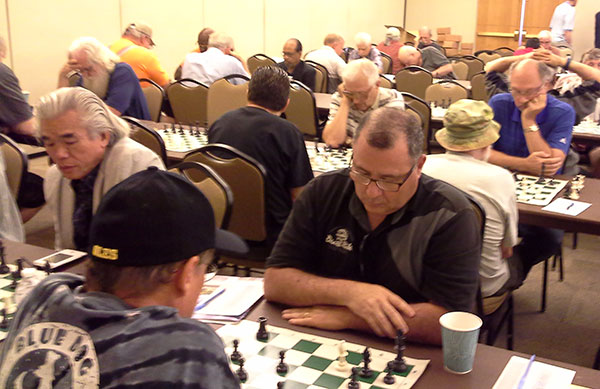
The US Senior was more than just a chance for players past their prime to enjoy some competition, it was a chance to meet up with old buddies as well | Photo: Alex Yermolinsky
The event was ably run by Chief Organizer Glenn Panner and TD Maret Thorpe. The latter was so busy that I was only able to catch her “at work” profile.
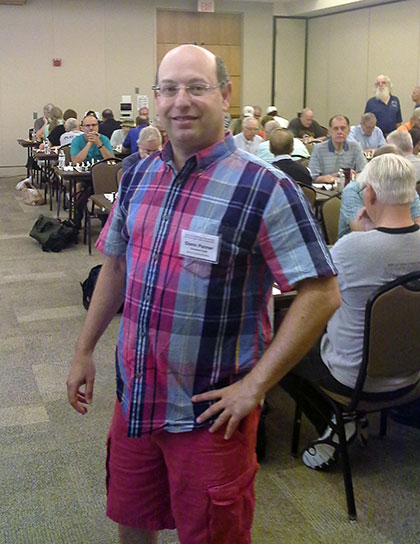
Chief Organizer Glenn Panner | Photo: Alex Yermolinsky
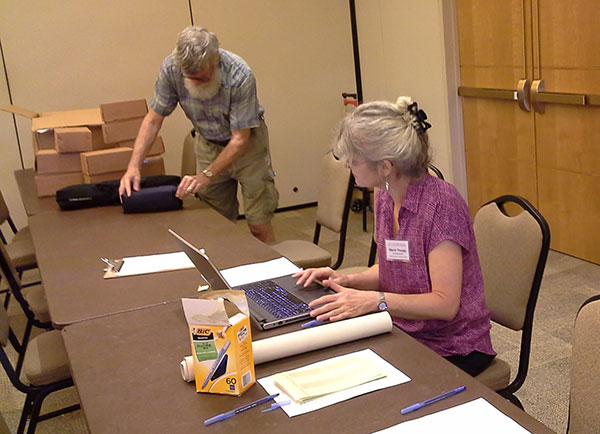
Tournament director Maret Thorpe (above) was never away from her work and exemplary. A $1,300 check and a nice plaque (below) was my reward for three days of hard work. | Photo: Alex Yermolinsky
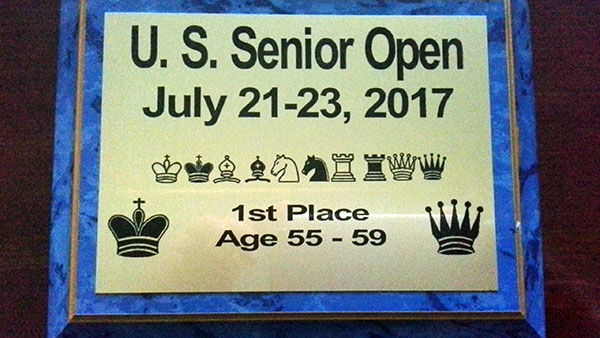
Plaques were given to the winners in different age groups, incremented by five years. Now I have five years to make an attempt at the 60-64 plaque.
There's also a question of going to the World Seniors next year. I haven't decided yet. I'd like to play a few more tournaments in 2017 to see where my chess is. (Ed: I think it safe to say we all hope you go!)
